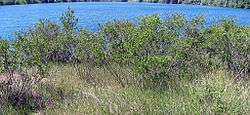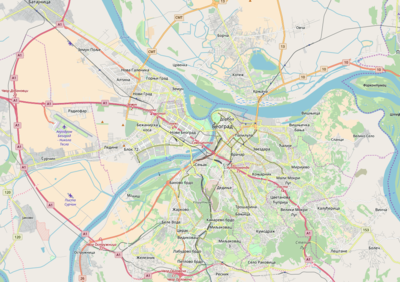Makiš
Makiš (Serbian: Макиш) is a forest and an urban neighborhood of Belgrade, the capital of Serbia. It is located in Belgrade's municipality of Čukarica.
Makiš Макиш | |
|---|---|
 Colony of false indigo bush in Makiš, on the Sava bank | |
 Makiš Location within Belgrade | |
| Coordinates: 44°45′28″N 20°22′01″E | |
| Country | |
| Region | Belgrade |
| Municipality | Čukarica |
| Population | |
| • Total | 1,217 |
| Time zone | UTC+1 (CET) |
| • Summer (DST) | UTC+2 (CEST) |
| Area code | +381(0)11 |
| Car plates | BG |
Location
_2015_-_Belgrade_Serbia_(19413598555).jpg)
Makiš is bordered by the Sava river and Sava Lake to the west and north, Čukarica and Čukarička Padina to the northeast, Julino Brdo, Žarkovo, Bele Vode and Rupčine to the east, Železnik to the south and Ostružnica to the southwest.[1]
Geography
For the most part, Makiš is a marshy forest, crossed by many small streams and canals, most notably the Marevica. Northern part is known as Jedek, western as Aščinica and central as Veliko Okno.[2][3] Part of the Sava's alluvial plane, the main section of the area, which covers several hundreds of hectares, is covered with gravel and sand which are 10,000 years old. In time, a plentiful water source formed.[4] Until the 20th century, Makiš was known for plentiful pastures used by the farmers from the nearby Žarkovo for their livestock.[5]
In total, Makiš forest spreads on 4 km2 (1.5 sq mi).[6]
Characteristics
| Year | Pop. | ±% |
|---|---|---|
| 1981 | 946 | — |
| 1991 | 953 | +0.7% |
| 2002 | 1,379 | +44.7% |
| 2011 | 1,217 | −11.7% |
| Source: [7][8][9][10] | ||
Makiš is for the most part non-residential (it had a population of only 1,217 in 2011), but important for the city industry and transportation. Major roads of Sava motorway and Old Obrenovac road cross through the area, marking western and eastern borders of the neighborhood. The railway also passes on the eastern border were the Makiš marshalling yard, largest one in south-east Europe, is located. The central facilities (including the water factory) of the Belgrade waterworks are located in Makiš, so as many gravel digging and cement plant on the bank of the Sava river.
First waterworks which supplied Belgrade from Makiš was finished in 1892, and the system was ceremonially opened on 12 July 1892, at Terazije. At the time, it was one of the most modern such facilities in Southeast Europe, projected by engineer Oskar Smrekar (1854-1935). For the first time in Belgrade, the underground water was used by the water supply system, instead of water springs. Original capacity was 2.800 m3 (98.9 cu ft) per day, for 80.000 citizens. By 1914, the production grew to 8.000 m3 (282.5 cu ft) daily. As Belgrade grew in the decades to come, the first water treatment facility ("water factory" Makiš 1) became operational in April 1987. It treats water from the Sava river. Another treatment facility, Makiš 2, was built from 2004 to September 2014, which should cover Belgrade's need for water until 2035.[4][11]
During the Interbellum, the waterworks company built the residential complex for its workers in Makiš, which originally consisted of two buildings within the industrial facility.[12]
Makiš Field
Eastern section, across the Sava motorway is called Makiš Field (Serbian: Макишко поље, romanized: Makiško polje). In the south and south-western section the Makiš marshalling yard and the neighborhood of Železnik are located.
After several plans for the Belgrade Metro since the 1960s, a new plan was announced on 3 July 2017, which envisions first two lines as the 22 km (14 mi) long Makiš-Mirijevo (via Sava Amphitheatre and Karaburma) and the 19.8 km (12.3 mi) long Zemun-Ustanička. The construction should start in the end of 2019 or the beginning of 2020 and should be finished in 3 to 4 years.[13] The project differs from all the previous ones as it sets the crossing of the major lines under the Belgrade Waterfront on the Sava bank, a highly controversial pet project of President of Serbia Aleksandar Vučić and mayor Mali, instead under the central city squares of Terazije or Republic Square as planned in the previous decades. Mayor of Belgrade Siniša Mali also announced that the first line is actually going to be Makiš Field-Mirijevo (that is, Višnjičko Polje) instead of Zemun-Ustanička which was planned as the first for decades. Architects and engineers reacted negatively, especially since both terminuses are at the moment nothing more than still un-urbanized heaths, though mayor Mali said that this line will connect the future projects which will "with the development of metro, bring billions of euros in investments and millions of square meters of the new business areas". Dr Ratomir Vračarević, traffic engineer and professor at the University of Belgrade's Faculty of Technical Sciences said how the surveys showed that this direction has a very low number of potential commuters, well below the profitability level. Architect Branislav Jovin, who authored the 1970s subway project, said that he believes Makiš was chosen because of the announced project of Tesla Grad ("Tesla City") by Bogoljub Karić, Karić, a tycoon who fled the country so that he wouldn't be trialed for financial schemes, returned after the change of government.[14] Three weeks later, city indeed announced that Karić's company "BK Group" won the competition for the project of "Tesla Grad" in Makiš Field with Mali personally giving advice what should be built in the complex. On the very day when this was announced, Karić stated that he already finalized everything at the meeting with Mali and city architect Milutin Folić and that the project is just one step away from realization.[15]
Tesla Grad
A residential-business complex, an "ambitiously envisioned international business center for fun and trade", was announced on 21 July 2017. The project covers an area of 680 m (2,230 ft), with 4,000,000 m2 (43,000,000 sq ft) of space, though site of the "BK Group" mentions only half of that. It is planned for 31,000 inhabitants. The starting point of the new settlement, from the city direction, will be a residential and commercial complex (apartments, shops, elementary schools, kindergartens, ambulances, cultural and sport venues, hotels) surrounding the 25-storeys high skyscraper. Lush vegetation is planned between the blocks, while cars will be parked in underground garages on the edges of the blocks. A main street through the settlement, in the entire north-south direction is also planned with the commercial zone around it. It will be parallel to the Sava motorway, with the green belt and avenues. Above the marshaling yard large salons for selling cars, ceramics, furniture, etc. are planned. The lots along the Belgrade bypass and Ostružnica Bridge are projected for the large hypermarkets and similar venues. Mayor Mali added that the national stadium might be built in this section, too.[15]
The main concern at the moment, is the fact that Makiš is Belgrade's main water source. In order to accommodate such a big project and make it possible, city government actually reduced the buffer zones around the water sources. This way, a construction is allowed close to the, and even though city authorities claim it is still enough to preserve the purity of the water, though some experts disagree.[14][15] They urged not to destroy the water sources and to preserve it for the future generations which may apply other solutions for water supply, like the use of the underground water sources from the valleys of the Sava and Drina rivers which yield more water of higher quality, but are distant from the city.[4] Geology engineer Branislav Božović said that building of such a major urban project on this location, beside the danger to the water sources, will also affect the micro climate of New Belgrade and Sava amphitheater and will cause the shutting off of the natural ventilation along the valleys of the rivers Topčiderska Reka, Železnička Reka and Ostružnička Reka.[16][17]
In September 2017 it was announced that the National Stadium will probably not be built within the scopes of Tesla Grad as there are complicated issues concerning the ownership of the land in Makiš.[18] Later, another location, across the river and close to Surčin was chosen. The entire Tesla Grad in general has been described as "even greater misfortune than Belgrade Waterfront".[17]
References
- Beograd - plan i vodič. Geokarta. 1999. ISBN 86-459-0006-8.
- Beograd - plan grada. M@gic M@p. 2006. ISBN 86-83501-53-1.
- Turističko područje Beograda. Geokarta. 2007. ISBN 86-459-0099-8.
- Branka Vasiljević (1 April 2018). "Makiško polje – zlatno izvorište prestonice" [Makiško field – golden water source of the capital]. Politika (in Serbian). p. 12.
- Goran Vesić (3 July 2020). Жарково, прича која траје [Žarkovo, story which continues]. Politika (in Serbian). p. 16.
- Anica Teofilović, Vesna Isajlović, Milica Grozdanić (2010). Пројекат "Зелена регулатива Београда" - IV фаѕа: План генералне регулације система зелених површина Београда (концепт плана). Urbanistički zavod Beograda.CS1 maint: multiple names: authors list (link)
- Osnovni skupovi stanovništva u zemlji – SFRJ, SR i SAP, opštine i mesne zajednice 31.03.1981, tabela 191. Savezni zavod za statistiku (txt file). 1983.
- Stanovništvo prema migracionim obeležjima – SFRJ, SR i SAP, opštine i mesne zajednice 31.03.1991, tabela 018. Savezni zavod za statistiku (txt file).
- Popis stanovništva po mesnim zajednicama, Saopštenje 40/2002, page 4. Zavod za informatiku i statistiku grada Beograda. 26 July 2002.
- Stanovništvo po opštinama i mesnim zajednicama, Popis 2011. Grad Beograd – Sektor statistike (xls file). 23 April 2015.
- Jovan Popović (8 June 2020). Два миленијума водовода у Београду [Two millennia of Belgrade's waterworks]. Politika (in Serbian). p. 23.
- Goran Vesić (2 August 2019). Социјални станови [Social housing]. Politika (in Serbian). p. 14.
- Dejan Aleksić (4 July 2017), ""BG vozom" do Resnika naredne godine, metroom tek od 2023.", Politika (in Serbian), p. 14
- Maja Nikolić (9 July 2017). "Ukrštanje linija metroa, umesto u centru, u Beogradu na vodi" (in Serbian). N1.
- Daliborka Mučibabić (25 July 2017), "Grad za više od 30.000 stanovnika na Makiškom polju", Politika (in Serbian), p. 16
- Sandra Petrušić (9 October 2018). "Cena diletantizma" [The price of dilettantism] (in Serbian). NIN.
- Sandra Petrušić (20 June 2019). Замлаћивање о нашем трошку [Messing around with our money]. NIN, No. 3573 (in Serbian). pp. 22–25.
- Daliborka Mučibabić (20 September 2017), "Izgradnja nacionalnog stadiona počinje 2018, lokacija tajna", Politika (in Serbian), p. 16